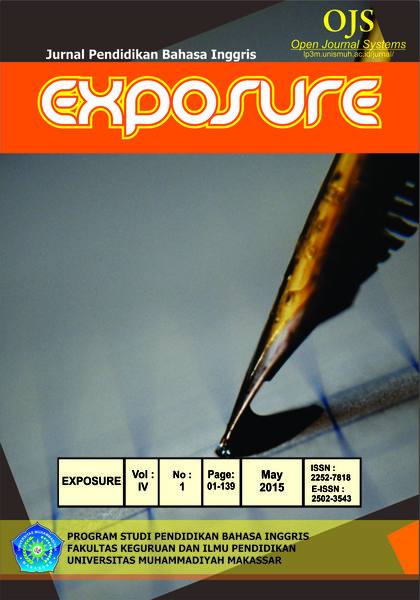ENRICHING VOCABULARY THROUGH SOCIAL INTERACTION MODEL
DOI:
https://doi.org/10.26618/exposure.v4i1.921Abstrak
The objective of this research was to find out the significance of the students’ achievement before and after learning vocabulary through Social Interaction Method at the eight class of SMP Guppi Samata Gowa. This research employed pre-experimental method with one group pretest and posttest design. There were two variables, namely dependent variable was the students’ vocabulary achievement and the independent variable was the application of Social Interaction Model in teaching vocabulary. The population was the students in the eighth grade of SMP Guppi Samata Gowa. The sample of the research consisted of 50 students which were taken by using cluster total sampling, 25 students were taken as an experimental class and 25 students were taken as a controlled class. The instrument was vocabulary test in the multiple-choice test. The multiple choice test consists of 10 items that consist of five choices. The findings of the research were students vocabulary used pre-test and post-test. The result of the data indicated that there was a significant difference between students’ post-test in experimental class and controlled class. The mean score of posttest (61.6) in experimental class was greater than the mean score of posttest (56) in controlled class and the standard deviation of posttest (8.94) in experimental class was greater than the standard deviation of posttest in controlled class (6.29). From t-test, the researcher found that the value of t-test (2.553) was greater than t-table (2.021) at the level of significance 0.05 with the degree of freedom (df) = 48.
Referensi
Bean, readence, and Baldwin. 2001. Vocabulary Self-Collection Strategy.(Online) http://www.litandlearn.lpb.org/strategies/strat_4vss.pdf accessed, on Augustus, 22th, 2012.
Beare, Kenneth. 1997. How to improve your vocabulary. Retrieved on 10th October (2009) from About. Com/ od/Englishvocabulary/ht/htvocab.htm.
British National Corpus, 2003. Oxford Advanced Learner’s Dictionary. Oxford University of Chicago and London.
Brown, H. Douglas. 1994. Teaching by Principle. An Interactive Approach to Language Pedagogic. Englewood Cliffs: Prentice Hall Regents.
Depdikbud. 1985. Garis- garis besar Pengajaran Bahasa Inggris. Jakarta: Departement Pendidikan dan Kebudayaan.
Gairns, R., and Redman, S. 1986. Working with Words. A Guide to teaching and learning vocabulary. Cambridge University Press.
Gay, L. R. 1981.educational research competencies for Analysis and application. Columbus: Merril Publishing Company.
Geer, David. 2000. How to improve your vocabulary .retrieved on 23rd June (2009) from http;/www.wordacker.com./en/article/howtoimprove vocabulary
Good. 1973. The dictionary of Education. New York: garwhil Book Company.
Halliday. M.A.K and Ruqaiya Hasan. 1985. Language, text, and Context: Aspects of language in a social semiotic perspective. Australia. Deakin University.
Harmer, Jeremy. 1991. The Practice of English Language Teaching (New Edition). Longman London and New York
Haggard, M.R. 1986. “The Vocabulary Self-Collection Strategy: Using Students Interest and World Knowledge to Enhance Vocabulary Growth.” Journal ofReadingVol.29, N7.(online)//davidabauman.com/sciwriting/vocabself.pdf accessed Date: June, 22th, 2011.
Hornby, A.S. 1986. Oxford advance learner’s dictionary of current English London: Oxford University Press.
Palmer .F. R. 1986. Semantics. Australia. Cambridge University press.
Rapp, Ruddel Martha. 2055. Teaching Content Reading and Writing. Sonoma State University.
Schelling, T. 1971: “Dynamic Models of Segregation,” Journal of Mathematical Sociology.
Webster, Noah. 1983. Webster Twenty Century of English Language. New York: Simon and sthucher.
Wesley, Addison Longman. 1998. Longman Language Activator “The World’s First Production Dictionary”. England Longman Corpus Network.
Unduhan
Diterbitkan
Terbitan
Bagian
Lisensi
Authors who publish with this journal agree to the following terms:
In order to assure the highest standards for published articles, a peer review policy is applied. In pursue of the compliance with academic standards, all parties involved in the publishing process (the authors, the editors and the editorial board and the reviewers) agree to meet the responsibilities stated below in accordance to the Journal publication ethics and malpractice statement.
Duties of Authors:
- The author(s) warrant that the submitted article is an original work, which has not been previously published, and that they have obtained an agreement from any co-author(s) prior to the manuscript’s submission;
- The author(s) should not submit articles describing essentially the same research to more than one journal;
- The authors(s) make certain that the manuscript meets the terms of the Manuscript Submission Guideline regarding appropriate academic citation and that no copyright infringement occurs;
- The authors(s) should inform the editors about any conflict of interests and report any errors they subsequently, discover in their manuscript.
Duties of Editors and the Editorial Board:
- The editors, together with the editorial board, are responsible for deciding upon the publication or rejection of the submitted manuscripts based only on their originality, significance, and relevance to the domains of the journal;
- The editors evaluate the manuscripts compliance with academic criteria, the domains of the journal and the guidelines;
- The editors must at all times respect the confidentiality of any information pertaining to the submitted manuscripts;
- The editors assign the review of each manuscript to two reviewers chosen according to their domains of expertise. The editors must take into account any conflict of interest reported by the authors and the reviewers.
- The editors must ensure that the comments and recommendations of the reviewers are sent to the author(s) in due time and that the manuscripts are returned to the editors, who take the final decision to publish them or not.
Authors are permitted and encouraged to post online a pre-publication manuscript (but not the Publisher’s final formatted PDF version of the Work) in institutional repositories or on their Websites prior to and during the submission process, as it can lead to productive exchanges, as well as earlier and greater citation of published work (see The Effect of Open Access). Any such posting made before acceptance and publication of the Work shall be updated upon publication to include a reference to the Publisher-assigned DOI (Digital Object Identifier) and a link to the online abstract for the final published Work in the Journal.

